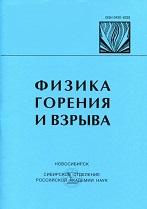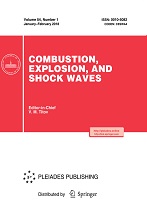|
Electrodynamic effects accompanying the propagation of current–carrying shock waves in a transverse magnetic field
E. I. Bichenkov
Lavrent'ev Institute of Hydrodynamics, Siberian Divan, Russian Academy of Sciences, Novosibirsk, 630090
Abstract:
This paper considers the shock–wave compression of a magnetic field by waves capable of trapping a certain current and transferring it within the shock front. It is shown that this current screens the electromagnetic radiation of the shock front and lowers the efficiency of magnetic compression. An analytical model is proposed that allows one to obtain the spatial distribution and magnitude of shock–induced current for both conducting materials and materials with a shock–induced transition from a nonconducting to a conducting state. It is shown that the current magnitude in conductors is determined primarily by the compressibility of the material, and the magnitude of trapped current is determined by the shock–wave structure and depends primarily on the conductivity of the material, the thickness of the shock front, and the location of the phase transition point within the wave front. In materials with dielectric—conductor transitions, current is entirely concentated inside the shock front, and the current magnitude is determined only by the shock–front structure. It is shown that shock–induced current is accompanied by an anticurrent of the same strength and opposite direction, which spreads over the conducting material surface adjacent to the shock wave, leading to a number of new electrodynamic effects. Decay of a current–carrying shock wave at the interface of materials, which accompanies classical decay of shock–wave discontinuity, is considered. An analysis of the magnetic moments of shock–induced currents shows that for compression of a homogenous magnetic field, the electromagnetic–energy radiation from high–conducting materials is insignificant. However, failure of a conductor involving loss of conductivity in a properly organized rarefaction wave can lead to radiation of a considerable amount of the magnetic field energy accumulated in the conducting material during shock–wave cumulation of the magnetic field.
Received: 25.11.1999
Accepted: 14.03.2000
Citation:
E. I. Bichenkov, “Electrodynamic effects accompanying the propagation of current–carrying shock waves in a transverse magnetic field”, Fizika Goreniya i Vzryva, 36:6 (2000), 146–152; Combustion, Explosion and Shock Waves, 36:6 (2000), 809–815
Linking options:
https://www.mathnet.ru/eng/fgv2266 https://www.mathnet.ru/eng/fgv/v36/i6/p146
|


| Statistics & downloads: |
| Abstract page: | 36 |
|





 Contact us:
Contact us: Terms of Use
Terms of Use
 Registration to the website
Registration to the website Logotypes
Logotypes








 Citation in format
Citation in format 